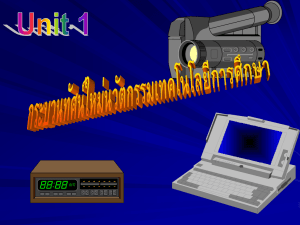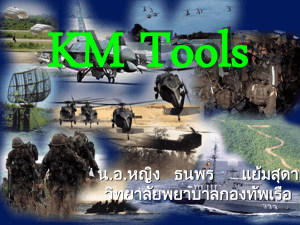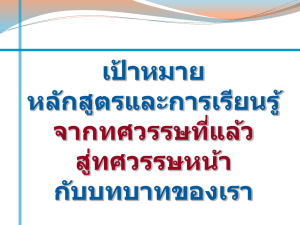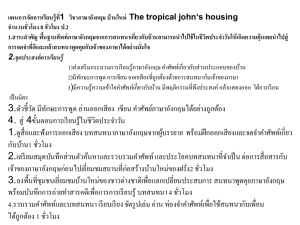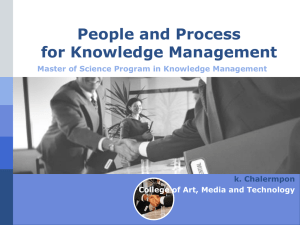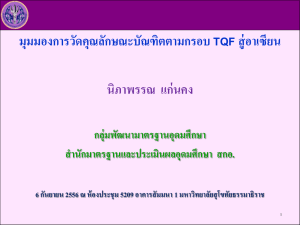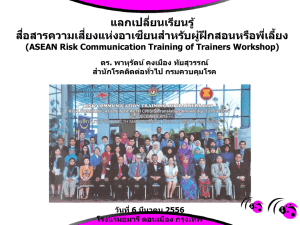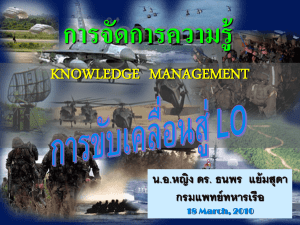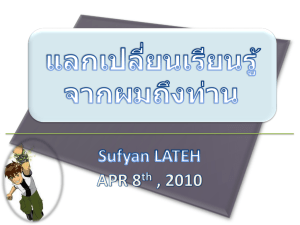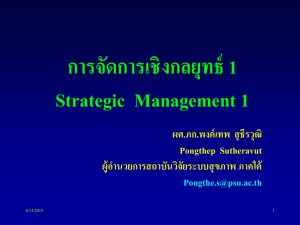ไฟล์ STUDY SKILL - การจัดการองค์ความรู้ สำหรับงานวิจัย
advertisement
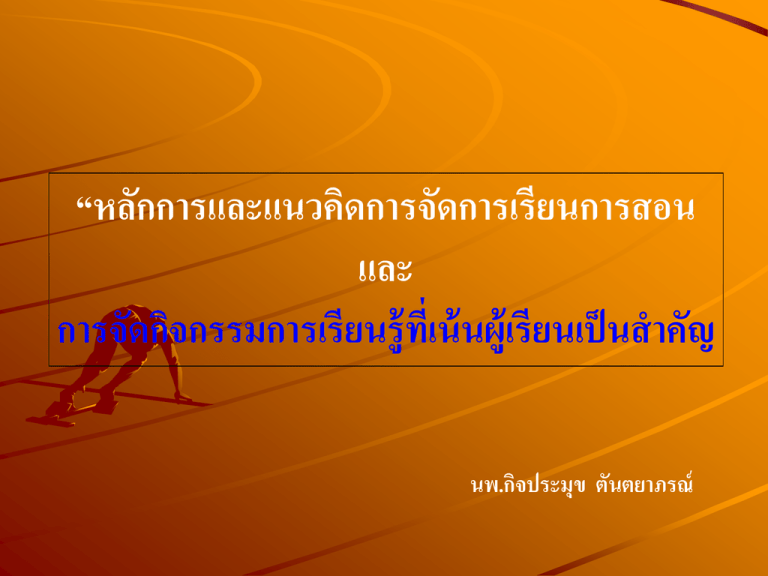
“หลักการและแนวคิดการจัดการเรียนการสอน และ การจัดกิจกรรมการเรียนรู้ ทเี่ น้ นผู้เรียนเป็ นสาคัญ นพ.กิจประมุข ตันตยาภรณ์ STUDY SKILLS TEACHING SKILLS LEARNING SKILLS หลักการ พ.ร.บ. การศึกษา 2542 1) เป็ นการศึกษาตลอดชีวติ สาหรับประชาชน 2) ให้ สังคมมีส่วนร่ วมในการจัดการศึกษา 3) การพัฒนาสาระและกระบวนการเรียนรู้ ให้ เป็ นไปอย่ างต่ อเนื่อง (มาตรา 8) TEACHING is not LEARNING teaching Interactions between teacher and student under the teacher’s responsibility in order to bring about expected changes in the student’s behaviour. purposes of teaching to help students to - acquire, retain and be able to use knowledge - understand, analyse, synthesize and evaluate - achieve skills - establish habits - develop attitudes (all of which correspond to the) Professional Profile teaching approaches - talk to students - talk with students - have them talk together - show students how - supervise them - provide opportunities for practice S. Abrahamson learning : A process resulting in some modification, relatively permanent, of the way of - thinking, - feeling, - doing, of the learner. the characteristics of learning learning is - Producing a behavioural change in the learner - leading to a relatively permanent change that is a gradual, adaptable and selective - resulting from practice, repetitions and experience - not directly observable principles of learning - learning is individual - motivation is the key - relevance of learning experience should be clear to the student1 - “feedback” to learner is important Conditions to facilitate learning An atmosphere which - encourages people to be active - emphasizes the personal nature of learning - accepts that difference is desirable - recognizes people’s right to make mistakes - tolerates imperfection - encourages openness of mind and trust in self - makes people feel respected and accepted - facilitates discovery - puts emphasis on self-evaluation in cooperation - permits confrontation of ideas Government Professional Ethics Professional Expectation University Student Service Professional Principles People Community เกณฑ์ ประเมินตัวบ่ งชี้ที่ 2.2 (สกอ.) มีกระบวนการเรี ยนรู้ที่เน้นผูเ้ รี ยนเป็ นสาคัญ (7 ข้อ) 1. มีกลไกการให้ความรู ้ความเข้าใจกับอาจารย์ผสู ้ อนถึงวัตถุประสงค์และเป้ าหมายของการ จัดการศึกษาทุกหลักสูตร 2. มีการออกแบบการเรี ยนการสอนและจัดกิจกรรมการเรี ยนรู ้ที่เน้นผูเ้ รี ยนเป็ นสาคัญทุกหลักสู ตร โดยมีการวิเคราะห์ศกั ยภาพผูเ้ รี ยน และเข้าใจผูเ้ รี ยนเป็ นรายบุคคล 3. มีการใช้สื่อและเทคโนโลยีหรื อวัตกรรมในการสอนเพื่อส่ งเสริ มการเรี ยนรู ้ทุกหลักสู ตร 4. มีการจัดการเรี ยนการสอนที่มีความยืดหยุน่ และหลากหลายที่จะสนองตอบต่อความต้องการของผูเ้ รี ยน 5. มีการประเมินผลการเรี ยนการสอนที่สอดคล้องกับสภาพการเรี ยนรู้ที่จดั ให้ผเู้ รี ยน และอิงพัฒนาการ ของผูเ้ รี ยนทุกหลักสูตร 6. มีการประเมินผลความพึงพอใจของผูเ้ รี ยนในเรื่ องคุณภาพการสอน และสิ่ งสนับสนุนการเรี ยนรู ้ ทุกหลักสูตร 7. มีระบบการปรับปรุ งวิธีการเรี ยนการสอนและพัฒนาผูเ้ รี ยนอย่างต่อเนื่องทุกหลักสูตร Teacher’s Roles Mentor Learning facilitator Student assessor On-the-job Role model Facilitator Curriculum evaluator Curriculum planner Role Mode Assessor Planner Information provider Resource developer Course organiser Resource developer Teaching Role model Lecturer Clinical or practical teacher Resource Material creator สิ่ งทีผ่ ้ ูสอนควรคานึง • สอนใคร • สอนอะไร • สอนทาไม • สอนอย่ างไร • สอนทีไ ่ หน • สอนเมื่อไร • สอนแล้ วประเมินอย่ างไร สอนอะไร ? วิชาการ :พืน้ ฐาน (ทัว่ ไป) ขั้นสู ง (วิชาเฉพาะ) วิชางาน : วิชาคน: คุณธรรม จริยธรรม ความเป็ นมนุษย์ ทักษะวิชาชีพ BASIC PRINCIPLE OF TEACHING PROCESS OBJECTIVE LEARNER CHARACTERISTICS SELECTION OF TEACHING METHOD EVALUATION FEED BACK (GLASSER : 1962) การเรียนการสอน ครู (อาจารย์ ) เป็ นศูนย์ กลาง และ นักเรียน (นักศึกษา) เป็ นศูนย์ กลาง (เน้ นผู้เรียนเป็ นสาคัญ) แผนภูมิการเรียนรู้ของผู้เรียน 10% 20% 70% Tell (I hear, I forget) Show (I see, I remember) Do (I do, I understand) (Dovid Kolb, 1984) Multiple Intelligences ความสามารถ IQ…. EQ… MQ... AQ… PQ… SQ… HQ… Sp. Q. (Intellectual Quotient) (Emotional Quotient) (Moral Quotient) (Adversity Quotient) (Play Quotient) (Social Quotient) (Humour Quotient) (Spiritual Quotient) แผนภูมกิ ารเรียนรู้ ของผู้เรียน TEACHER - CENTERED STUDENT - CENTERED Yes Small PBL group Distance learning Lecture Prescribed Reading or study Student Centered No No Yes Working on own Control of learning by student A model of Learning Problem Solving Process EXPERIENTIAL LEARNING MODEL (Active L.) Concrete Experience (1) Active Experimentation Application (4) Reflective Observation (2) Abstract Generalization (3) TRADITIONAL MODEL (Passive L.) Generalization (1) Concrete Experience (4) Reflective Observation (2) Experimentation Application (3) “เปรียบเทียบการจัดกระบวนการเรียนรู้ ” ประเด็น การดาเนินการ จุดเน้ น บทบาทนักเรียน ครู เป็ นศูนย์ กลาง คนเดียว เนือ้ หา ฟัง จา เงียบ เฉย สอบ นักเรียนเป็ นศูนย์ กลาง กลุ่ม / เดีย่ ว กระบวนการเรียนรู้ มีส่วนร่ วม อภิปราย ปฏิสัมพันธ์ กระตือรือร้ น บทบาทครู สอน บรรยาย สั่ ง ประเมินผล บรรยากาศ - เป็ นทางการ - ปิ ดกั้นความคิด สร้ างสรรค์ -โรงสอน ชี้แนะ อานวยความสะดวก วางแผน ให้ คาปรึกษา ประเมินผล แบบ นักเรียนมีส่วนร่ วม - เป็ นกันเอง ผ่อนคลาย - กระตุ้นความคิดสร้ างสรรค์ - เป็ นการเรียนรู้ ร่วมกัน - โรงเรียน นอกจากจะแบ่ งการสอนโดยพิจารณาจากผู้เรียนและผู้สอน เป็ นหลักแล้ ว ยังมีการแบ่ งประเภทการสอนโดยจาแนกออกตาม ขนาดของกลุ่มผู้เรียน ซึ่ง Brown และ Thronton ได้ แบ่ งเป็ น 4 แบบ 1. การสอนกลุ่มใหญ่ (มากกว่ า 60 คน) 2. การสอนกลุ่มขนาดกลาง (35-60 คน) 3. การสอนกลุ่มย่ อย (5-10 คน) 4. การเรียนโดยอิสระ (Independent study) the definition of problem-based learning (PBL) Problem-based learning is a process where-by student learns by using a problem as a stimulus to discover what information is needed to understand and facilitate the resolution of the problem. The problem is encountered right at the beginning of the learning process. What is a problem ? A problem for the purposes of learning is the (more of less neutral) description of a certain number of phenomena or events which appear to be related in certain ways. The students must first learn to account for these phenomena, and then gradually work out a plan of action to resolve the problem and acquire the necessary skills to implement it. Problems may be constructed to cover several topics and presented in various different formats, but the basic principle is always the same: these are phenomena or situations for which the students must produce one or more explanations and/or propose and implement the relevant solution. The aims of problem-based learning The students for whose training we are responsible must Acquire: 1. A fund of essential skills and knowledge which they can easily retain and retrieve later in the course of their professional work. 2. The ability to make use of their skills and knowledge to evaluate and manage the health problems of individuals and the community. 3. The ability to extend or improve these skills and this knowledge, and to take appropriate action in the face of any problems they may encounter in the future. Problem-based learning sets out to accomplish all three of these aims simultaneously. สาหรับวิธีการสอนทีร่ ะบุไว้ ในคู่มือประเมินผลการสอน อาจารย์ จุฬาลงกรณ์ มหาวิทยาลัย ปี การศึกษา 2540 กาหนดแบบอย่ างของ การสอนไว้ 12 แผนการสอน ดังต่ อไปนี้ การสอนแบบบรรยาย การสอบแบบ Problem-based Learning การสอนแบบสาธิต การสอนแบบในห้ องปฏิบัติการ การสอนแบบโครงการ การสอนแบบสั มมนา การสอนแบบฝึ กภาคสนาม การสอนแบบบรรยายเชิ งอภิปราย (Discussion) การสอนแบบทบทวน (Tutorial Group) การสอนแบบ Brain storming Group การสอนบรรยายเชิ งปฏิบัติ การสอนแบบปฏิบัติ PRINCIPLES OF LEARNING LEARNING IS AN INDIVIDUAL MATTER DEGREE AND SPEED OF LEARNING RELATED TO MOTIVATION LEARNING MORE EFFICIENT WHEN EXPERIENCE HAS MEANING LEARNING MORE EFFICIENT WITH “FEEDBACK” Process of Learning Type Expected experience (1-5) 1. Lecture Content (5) 2. Bed side Holistic approach (5) Ethics (4) Content + Clinical skill (2) 3. Conference Team work (3) Process of thinking (2) Content (1) Type Expected experience (1-5) 4. Small group (PBL) Process of thinking + Ethics (5) Team work (4) Content (2) 5. OPD Holistic approach (5) Clinical skill (5) Content (1) 6. DR + OR + Ward Clinical skill (5) Team work (3) 7. SDL Process of thinking (5) Content (4) (SDL = Self-Directed Learning) TEACHING CLASS OF LEARNING OBJECTIVE COGNITVE AFFECTIVE PSYCHOMOTOR LOW HIGH LOW HIGH LOW LECTURE…………………………………. DEMONSTRATION……………................. GROUP DISCUSSION……………………. TUTORIAL………………………………… ROLE-PLAYING………………………….. CASE STUDIES……………………………. BRAIN-STORMING………………………. COMPUTER-STORMING……………….. INDEPENDENT STUDY………………..… (PROGRAM, etc.) (DAVIES, IK., THE MANAGEMENT OF LEARNING 1971) HIGH การพิจารณาบุคลากรเข้ าสู่ วชิ าชีพ เช่ น : คุณสมบัตทิ พี่ งึ ประสงค์ ของแพทย์ มีดงั นี้ : - ความรักในวิชาชีพ - ศักยภาพในการพัฒนาตนเอง - เห็นประโยชน์ส่วนรวมเป็ นหลัก - ความรับผิดชอบ - ความอดทน (คุณสมบัติ..ต่อ) - ความสามารถในการสื่ อสาร ความใฝ่ รู้ ความสามารถในการปฏิบตั ิงานร่ วมกับผูอ้ ื่น บุคลิกภาพ คุณธรรม/จริ ยธรรม วงจรการเรียนรู้ ทางคลินิก (clinical learning cycle) ขั้นตอน 1 ขั้นตอน 2 ขั้นตอน 3 ขั้นตอน 4 ขั้นตอน 5 ขั้นตอน 6 การสาธิต การฝึ กกับหุ่น หรื อผูป้ ่ วยจาลอง การซักซ้อมก่อนการปฏิบตั ิกบั ผูป้ ่ วยจริ ง การฝึ กปฏิบตั ิกบั ผูป้ ่ วย การทบทวนแก้ไขข้อบกพร่ อง เพื่อปรับปรุ ง การสอบหรื อการประเมินความสามารถ ในการปฏิบตั ิทกั ษะ TRADITIONAL PBL TEACHER TUTOR INFORMATIONS OR DISCIPLINES PRESENTATION APROBLEM ANALYSIS PROBLEM ORGANIZE APPLICATION GENERATE HYPOTHESIS & COLLECT INFORMATION SELF SOLVING TUTOR (FEEDBACK) ASSUMPTIONS ABOUT CONCEPT OF THE LEARNER TEACHER-DIRECTED LEARNING (TDL) DEPENDENT PERSONALITY ROLE OF LEARNER’S EXPERIENCE TO BE BUILT ON MORE THANUSED OF RESOURCES SELF-DIRECTED LEARNING (SDL) INCREASINGLY SELF-DIRECTED ORGANISM A RICH RESOURCE FOR LEARNING READINESS TO LEARN VARIES WITH LEVELS OF MATURATION DEVELOPS FROM LIFE TASKS AND PROBLEMS ORIENTATION OF LEARNING SUBJECT-CENTERED MOTIVATION EXTERNAL ‘REWARDS AND PUNISHMENTS TASK-OR PROBLEMCENTERED INTERNAL INCENTIVES, CURIOSITY (TDL) (SDL) Selection of teaching method (การพิจารณาเลือกวิธีการสอน) ************* 1. METHOD SUITABLE TO OBJECTIVES & CONTENT OF THE COURSE 2. METHOD SHOULD BE ADAPTED TO THE CAPACITY OF THE STUDENT 3. METHOD SHOULD BE IN ACCORD WITH SOUND PSYCHOLOGICAL PRINCIPLES 4. METHOD SHOULD SUIT TO TEACHER PERSONALITY AND CAPITALIZED AND 5. HIS HER SPECIAL ASSETS METHOD SHOULD BE USED CREATIVELY การจัดการเรียนการสอนโดยยึดผู้เรียนเป็ นศูนย์ กลาง (Student Centered) 1) ควรจัดให้ ผู้เรียนมี Active Participation ทาง : - physical - intellectual - emotional - social 2) ผู้สอนควรดาเดินการดังนี:้ 2.1 จัดกิจกรรม หรือประสบการณ์ ทีเ่ อือ้ ให้ ผู้เรียนมีส่วนร่ วม และใช้ กระบวนการเรียนรู้ทเี่ หมาะสม 2.2 ลดบทบาทไปเป็ นผู้อานวยความสะดวกให้ ผ้เู รียนดาเนินกิจกรรมได้ อย่ างมีประสิ ทธิภาพ I NEVER TEACH MY PUPILS, I ONLY ATTEMPT TO PROVIDE THE CONDITION IN WHICH THEY CAN LEARN (ALBERT EINSTEIN)
